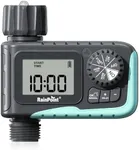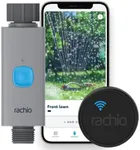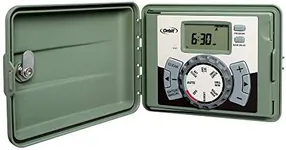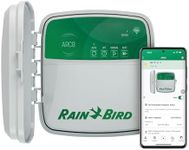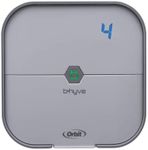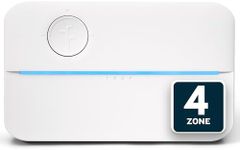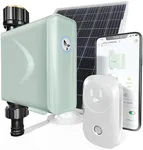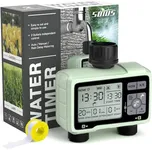Buying Guide for the Best Irrigation Timers
Choosing the right irrigation timer can make a significant difference in maintaining a healthy garden or lawn. An irrigation timer automates the watering process, ensuring your plants get the right amount of water at the right time. When selecting an irrigation timer, it's important to consider several key specifications to ensure it meets your specific needs. Understanding these specs will help you make an informed decision and keep your garden thriving with minimal effort.Number of ZonesThe number of zones refers to the different areas or sections of your garden that the timer can control independently. This is important because different plants may have different watering needs. If you have a large garden with various types of plants, you might need a timer with multiple zones. Typically, timers come with 1 to 12 zones. For a small garden, 1-2 zones might be sufficient, while larger gardens with diverse plant types might require 4-12 zones.
Programming FlexibilityProgramming flexibility refers to how customizable the watering schedules are. This is crucial for ensuring that your plants receive the right amount of water at the right times. Some timers offer basic settings with fixed intervals, while others allow for more detailed programming, such as specific days of the week, multiple start times per day, and seasonal adjustments. If you have a variety of plants with different watering needs, look for a timer with advanced programming options. For simpler needs, a basic timer with fewer settings might suffice.
Power SourceIrrigation timers can be powered by batteries, electricity, or solar energy. The power source is important for ensuring the timer operates reliably. Battery-powered timers are easy to install and portable but require regular battery changes. Electric timers are more reliable for long-term use but need to be installed near a power outlet. Solar-powered timers are eco-friendly and can save on energy costs but may not be as reliable in areas with limited sunlight. Choose a power source that fits your garden setup and maintenance preferences.
Weather SensingWeather sensing features allow the timer to adjust watering schedules based on current weather conditions, such as rain, temperature, and humidity. This is important for conserving water and preventing overwatering. Some timers come with built-in sensors, while others can be connected to external weather sensors. If you live in an area with variable weather, a timer with weather sensing capabilities can be very beneficial. For regions with more consistent weather, this feature might be less critical.
Ease of UseEase of use refers to how user-friendly the timer is in terms of setup and operation. This is important for ensuring that you can easily manage your watering schedules without frustration. Look for timers with clear displays, intuitive controls, and easy-to-follow instructions. Some timers also offer smartphone connectivity for remote control and monitoring. If you're not tech-savvy, a simpler model with straightforward controls might be best. For those comfortable with technology, a more advanced model with app integration could offer added convenience.
DurabilityDurability refers to how well the timer can withstand outdoor conditions, such as exposure to water, sunlight, and temperature fluctuations. This is important for ensuring the timer lasts for many seasons. Look for timers made from high-quality, weather-resistant materials. If you live in an area with harsh weather conditions, investing in a more durable timer can save you from frequent replacements. For milder climates, standard durability might be sufficient.
